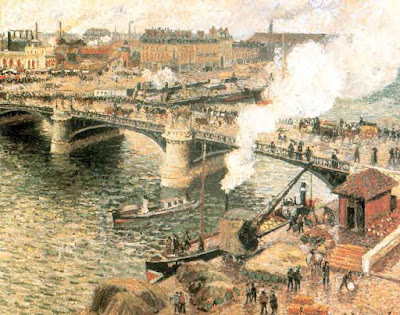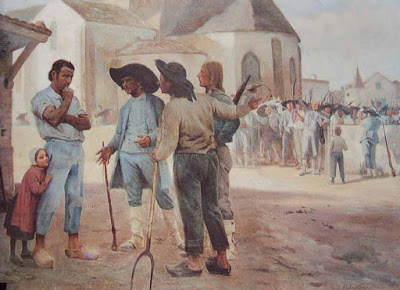 Degas, Dance Foyer of the Opera at rue le Peletier (1872)
Degas, Dance Foyer of the Opera at rue le Peletier (1872)
"Here are some chairs I noticed. An empty chair at the natural optical centre of Degas’s
Dance Foyer of the Opera at rue le Peletier (1872), occupied by a fan and a puddle of white cloth. It is waiting – and the viewer is waiting, subliminally – for its occupant to return and claim the fan. It is reserved. Someone has bagged it. Not a circumstance you often see painted, though common enough in real life. Nor is the violinist playing. He is pausing, his bow at rest on his trouser leg. Degas has painted a pause. A thing that hasn’t been painted before. In the same picture, a dancer to the right, in the foreground, is sitting on another chair, her legs stiffly out front – ungainly yet graceful, resting. The upright back of the chair is invisible because it is under her unmanageably stiff tulle skirt, lifting the skirt up and slightly out of alignment. All her fatigue is there in the mistake, the carelessness of her plonking down."
New Statesman: How the impressionists found a new way of capturing the remarkable in everyday life
Guardian: Inventing Impressionism review – a superb exhibition in every respect
The National Gallery: Inventing Impressionism
YouTube: Inventing Impressionism | The National Gallery, London
 The Galettes, 1882, Claude Monet.
Impressionism: Art and Modernity
The Galettes, 1882, Claude Monet.
Impressionism: Art and Modernity
 La Grenouillère, Claude Monet, 1869
La Grenouillère, Claude Monet, 1869
"In 1874, a group of artists called the Anonymous Society of Painters, Sculptors, Printmakers, etc. organized an exhibition in Paris that launched the movement called Impressionism. Its founding members included
Claude Monet,
Edgar Degas, and Camille Pissarro, among others. The group was unified only by its independence from the official annual
Salon, for which a jury of artists from the Académie des Beaux-Arts selected artworks and awarded medals. The independent artists, despite their diverse approaches to painting, appeared to contemporaries as a group. While conservative critics panned their work for its unfinished, sketchlike appearance, more progressive writers praised it for its depiction of modern life. Edmond Duranty, for example, in his 1876 essay
La Nouvelle Peinture (The New Painting), wrote of their depiction of contemporary subject matter in a suitably innovative style as a revolution in painting. The exhibiting collective avoided choosing a title that would imply a unified movement or school, although some of them subsequently adopted the name by which they would eventually be known, the Impressionists. Their work is recognized today for its modernity, embodied in its rejection of established styles, its incorporation of new technology and ideas, and its depiction of modern life. ..."
Metropolitan Museum of Art
 Garden at Argenteuil, Edouard Manet, 1874
The Age of Impressionism
Garden at Argenteuil, Edouard Manet, 1874
The Age of Impressionism
 Pierre-Auguste Renoir, Venice, the Doge's Palace, 1881
Pierre-Auguste Renoir, Venice, the Doge's Palace, 1881
"Showcasing the Clark's renowned holdings of French Impressionist paintings, this exhibition features seventy-three works of art, including works by Edgar Degas, Édouard Manet, Claude Monet, Berthe Morisot, Camille Pissarro, Pierre-Auguste Renoir, and Alfred Sisley. Also represented are Pierre Bonnard, William-Adolphe Bouguereau, Jean-Baptiste-Camille Corot, Jéan-Leon Gérôme, Jean-François Millet, and Henri de Toulouse-Lautrec, among others. The MFAH exhibition tells not only the story of Sterling and Francine Clark's devotion and passion for collecting but also of painting in nineteenth-century France, including the Orientalist works of Gérôme, Barbizon paintings of Corot and Théodore Rousseau, Impressionist masterpieces of Degas, Manet, Monet, Pissarro, Renoir, and Sisley, and Early Modern output of Bonnard and Lautrec. Portraits, landscapes, marines, still lifes, and scenes of everyday life by twenty-five artists, spanning seventy years, are on view."
The Clark
YouTube: The Age of Impressionism
 Camille Pissarro, The River Oise near Pontoise, 1873
Discovering the Impressionists: Paul Durand-Ruel and the New Painting
Camille Pissarro, The River Oise near Pontoise, 1873
Discovering the Impressionists: Paul Durand-Ruel and the New Painting
 Pont Boieldieu in Rouen, Rainy Weather, 1896, Camille Pissarro
Pont Boieldieu in Rouen, Rainy Weather, 1896, Camille Pissarro
"This extraordinary gathering of paintings reveals the story of Monet, Renoir, Degas, Manet, Pissarro, and their visionary art dealer and champion, Paul Durand-Ruel. The artists now known as the Impressionists once struggled to introduce their new style of painting to critics and the public. With Durand-Ruel, they forged an identity and moved from the margins to international fame. Recaptured in this exhibition are the often forgotten setbacks and breakthrough triumphs of Impressionism. Monet’s visions of graceful poplar trees, Renoir’s joyous dance paintings, and Pissarro’s luminous cityscapes showcase the talent recognized by Durand-Ruel. Durand-Ruel secured Impressionism’s place in history through tireless promotion across Europe and the United States—enthusiastic Americans ensured its success."
Philadelphia Museum of Art
Philadelphia Museum of Art: Featured Artists
NY Times: Paul Durand-Ruel, the Paris Dealer Who Put Impressionism on the Map
WSJ: ‘Durand-Ruel’ Impressionism Show Tours Paris, London, Philadelphia
YouTube: Discovering the Impressionists: Paul Durand Ruel at the Philadelphia Museum of Art
Undressed: The Fashion of Privacy

"Presented as a companion to the major exhibition
Impressionism, Fashion, and Modernity, which investigates Impressionist artists’ expressive use of contemporary fashion in depictions of public life, this exhibition focuses on the private side of apparel—and the lack thereof. Featuring more than 120 drawings and prints, as well as select paintings, photographs, and materials from the Ryerson and Burnham Libraries,
Undressed explores the connotations of informal dress and undress in intimate, personal situations."
The Art Institute of Chicago
 Barbizon through Impressionism: Great French Paintings from the Clark
Barbizon through Impressionism: Great French Paintings from the Clark
 Camille Corot, Road by the Water, c. 1865–70.
Camille Corot, Road by the Water, c. 1865–70.
"The international tour of French nineteenth-century paintings from the Sterling and Francine Clark Art Institute made its ninth stop at the Shanghai Museum. The Clark’s world tour has drawn more than 1.6 million visitors since it began in October 2010. Open to the public from September 18–December 1, 2013, the exhibition in Shanghai features seventy-three paintings, including works by Pierre-Auguste Renoir, Claude Monet, Edgar Degas, Édouard Manet, and Camille Pissarro, as well as those by Pierre Bonnard, Jean-Baptiste-Camille Corot, Paul Gauguin, Jean-François Millet, Alfred Sisley, Henri de Toulouse-Lautrec, William-Adolphe Bouguereau and Jean-Léon Gérôme. Visit the
Masterpiece Gallery to view the works included in the exhibition."
The Clark
The Clark: Slideshows
amazon: Great French Paintings from the Clark: Barbizon through Impressionism


















































